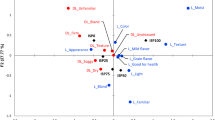Abstract
In recent years, a growing interest in foods of plant origin, especially plant protein foods, has become evident. A large number of low-technology, Oriental soybean foods have appeared on the American market outside the Oriental community. The most popular one is tofu. Tempeh, another soybean protein food, also has attracted a lot of attention. Tempeh has not yet been accepted to the extent that tofu has, but it is becoming a hamburger-alternative for vegetarians, now numbering 10–15 million in the United States. According to information published by the Soyfoods Center of California, the number of tofu producers in North America rose from 50 in 1975 to 182 in 1983, and annual production has increased from 13,250 tons in 1979 to 27,500 tons in 1983. The annual tempeh production was estimated at 500 tons in 1982. Changes in the perceptions of soybean foods as they pertain to health and social status seem to be the determining factors behind the momentous expansion of Oriental soybean foods. Therefore, the growth trend is expected to be continuing for some time into the future. Tofu is made by curdling the protein with a calcium or magnesium salt from a water extract of whole soybeans. It is a highly hydrated, gelatinous product with a soft, smooth texture and a bland taste. Therefore, tofu can be easily incorporated with other foodstuffs and used in nearly every culinary context, from salad to dessert and from breakfast foods to burgers. Tempeh is made by fermenting boiled soybeans withRhizopus oligosporus. After 20–24 hr at 30 C, the beans are covered with white mycelium that binds the beans together to form a firm cake. It can be seasoned, and cooked by frying, roasting or baking — just like meat.
Similar content being viewed by others
References
Wang, H.L., in Handbook of Processing and Ulitization of Agriculture, Vol. II, Part 2, Plant Products, edited by I.A. Wolff, CRC Press, Inc., Boca Raton, Florida, 1983, p. 91.
Shurtleff, W., and A. Aoyagi, Soyfood Industry Directory and Databook, The Soyfoods Center, Lafayette, California, 1983.
Leviton, R., Soyfoods 8:33 (1983).
Swain, E.W., H.L. Wang and C.W. Hesseltine, unpublished data.
Wang, H.L., E.W. Swain, C.W. Hesseltine and H.D. Heath, J. Food Sci. 44:1510 (1979).
Watanabe, T., C. Fukamachi, O. Nakayama, Y. Teramachi, K. Abe, S. Suruga and S. Mivanage, The Report of Food Research Institute, Ministry of Agriculture and Forestry, Japan, 14B (1960) (in Japanese).
Wilkens, W.F., L.R. Mattick and D.B. Hand, Food Technol. 21:1630 (1967).
Nelson, A.I., M.P. Steinberg and L.S. Wei, J. Food Sci. 41:57 (1976).
Fukushima, D., in Chemical Deterioration of Proteins, edited by J.R. Whitaker and Masao Fugimaki, ACS Symp. Ser. 123, Washington, D.C., 1980, p. 211.
Wang, H.L., and C.W. Hesseltine, Process Biochem. 17:7 (1982).
Appurao, A.G., and M.S. Narasingo Rao, Cereal Chem. 52:21 (1975).
Tsai, S.J., C.Y. Lan, C.S. Kao and S.C. Chen, J. Food Sci. 46:1734 (1981).
Aoki, H., Nippon Hogei Kagaku Kaishi 39:277 (1965) (in Japanese).
Wang, H.L., E.W. Swain, W.F. Kwolek and W.R. Fehr, Cereal Chem. 60:185 (1983).
Saio, K., Cereal Foods World 24:342 (1979).
Saio, K., M. Kamiya and T. Watanabe, Agric. Biol. Chem. 33:1301 (1969).
Skurray, G., J. Cunich and O. Carter, Food Chem. 6:89 (1980).
Hesseltine, C.W., M. Smith, B. Bradle and Ko Swan Djien, Dev. Ind. Microbiol. 4:275 (1963).
Wang, H.L., E.W. Swain and C.W. Hesseltine, J. Food Sci. 40:168 (1975).
Hesseltine, C.W., M. Smith and H.L. Wang, Dev. Ind. Microbiol. 8:179 (1967).
Wang, H.L., D.I. Ruttle and C.W. Hesseltine, J. Nutr. 96:109 (1968).
Wang, H.L. and C.W. Hesseltine, in Microbial Technology, edited by H.J. Peppler and D. Perlman, Vol. II, 1979, p. 96.
Author information
Authors and Affiliations
About this article
Cite this article
Wang, H.L. Tofu and tempeh as potential protein sources in the western diet. J Am Oil Chem Soc 61, 528–534 (1984). https://doi.org/10.1007/BF02677023
Received:
Issue Date:
DOI: https://doi.org/10.1007/BF02677023




